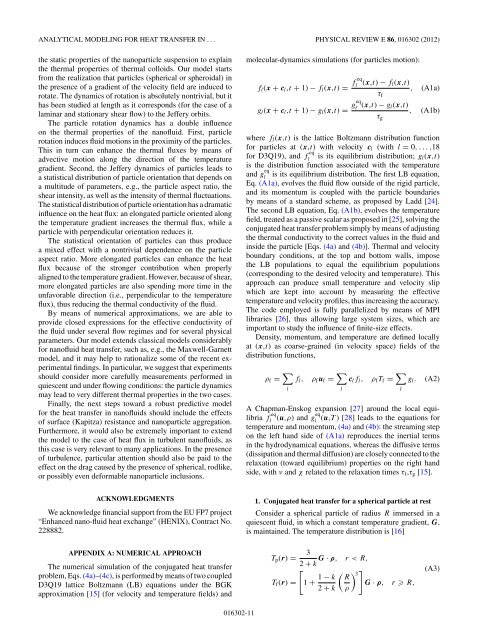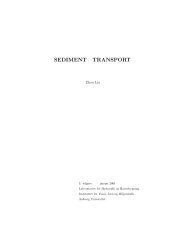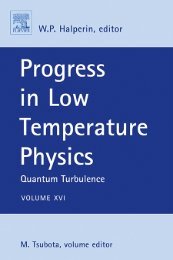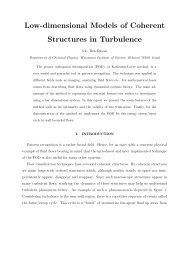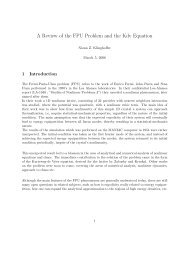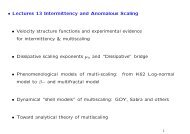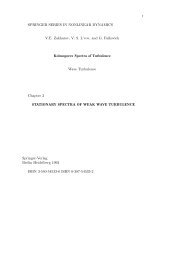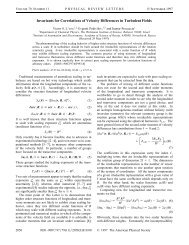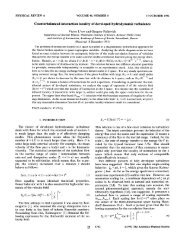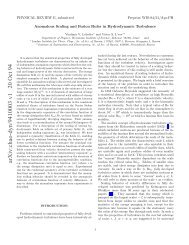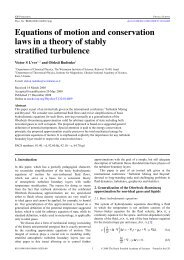Analytical modeling for heat transfer in sheared flows of nanofluids
Analytical modeling for heat transfer in sheared flows of nanofluids
Analytical modeling for heat transfer in sheared flows of nanofluids
You also want an ePaper? Increase the reach of your titles
YUMPU automatically turns print PDFs into web optimized ePapers that Google loves.
ANALYTICAL MODELING FOR HEAT TRANSFER IN ... PHYSICAL REVIEW E 86, 016302 (2012)<br />
the static properties <strong>of</strong> the nanoparticle suspension to expla<strong>in</strong><br />
the thermal properties <strong>of</strong> thermal colloids. Our model starts<br />
from the realization that particles (spherical or spheroidal) <strong>in</strong><br />
the presence <strong>of</strong> a gradient <strong>of</strong> the velocity field are <strong>in</strong>duced to<br />
rotate. The dynamics <strong>of</strong> rotation is absolutely nontrivial, but it<br />
has been studied at length as it corresponds (<strong>for</strong> the case <strong>of</strong> a<br />
lam<strong>in</strong>ar and stationary shear flow) to the Jeffery orbits.<br />
The particle rotation dynamics has a double <strong>in</strong>fluence<br />
on the thermal properties <strong>of</strong> the nan<strong>of</strong>luid. First, particle<br />
rotation <strong>in</strong>duces fluid motions <strong>in</strong> the proximity <strong>of</strong> the particles.<br />
This <strong>in</strong> turn can enhance the thermal fluxes by means <strong>of</strong><br />
advective motion along the direction <strong>of</strong> the temperature<br />
gradient. Second, the Jeffery dynamics <strong>of</strong> particles leads to<br />
a statistical distribution <strong>of</strong> particle orientation that depends on<br />
a multitude <strong>of</strong> parameters, e.g., the particle aspect ratio, the<br />
shear <strong>in</strong>tensity, as well as the <strong>in</strong>tensity <strong>of</strong> thermal fluctuations.<br />
The statistical distribution <strong>of</strong> particle orientation has a dramatic<br />
<strong>in</strong>fluence on the <strong>heat</strong> flux: an elongated particle oriented along<br />
the temperature gradient <strong>in</strong>creases the thermal flux, while a<br />
particle with perpendicular orientation reduces it.<br />
The statistical orientation <strong>of</strong> particles can thus produce<br />
a mixed effect with a nontrivial dependence on the particle<br />
aspect ratio. More elongated particles can enhance the <strong>heat</strong><br />
flux because <strong>of</strong> the stronger contribution when properly<br />
aligned to the temperature gradient. However, because <strong>of</strong> shear,<br />
more elongated particles are also spend<strong>in</strong>g more time <strong>in</strong> the<br />
unfavorable direction (i.e., perpendicular to the temperature<br />
flux), thus reduc<strong>in</strong>g the thermal conductivity <strong>of</strong> the fluid.<br />
By means <strong>of</strong> numerical approximations, we are able to<br />
provide closed expressions <strong>for</strong> the effective conductivity <strong>of</strong><br />
the fluid under several flow regimes and <strong>for</strong> several physical<br />
parameters. Our model extends classical models considerably<br />
<strong>for</strong> nan<strong>of</strong>luid <strong>heat</strong> <strong>transfer</strong>, such as, e.g., the Maxwell-Garnett<br />
model, and it may help to rationalize some <strong>of</strong> the recent experimental<br />
f<strong>in</strong>d<strong>in</strong>gs. In particular, we suggest that experiments<br />
should consider more carefully measurements per<strong>for</strong>med <strong>in</strong><br />
quiescent and under flow<strong>in</strong>g conditions: the particle dynamics<br />
may lead to very different thermal properties <strong>in</strong> the two cases.<br />
F<strong>in</strong>ally, the next steps toward a robust predictive model<br />
<strong>for</strong> the <strong>heat</strong> <strong>transfer</strong> <strong>in</strong> nan<strong>of</strong>luids should <strong>in</strong>clude the effects<br />
<strong>of</strong> surface (Kapitza) resistance and nanoparticle aggregation.<br />
Furthermore, it would also be extremely important to extend<br />
the model to the case <strong>of</strong> <strong>heat</strong> flux <strong>in</strong> turbulent nan<strong>of</strong>luids, as<br />
this case is very relevant to many applications. In the presence<br />
<strong>of</strong> turbulence, particular attention should also be paid to the<br />
effect on the drag caused by the presence <strong>of</strong> spherical, rodlike,<br />
or possibly even de<strong>for</strong>mable nanoparticle <strong>in</strong>clusions.<br />
ACKNOWLEDGMENTS<br />
We acknowledge f<strong>in</strong>ancial support from the EU FP7 project<br />
“Enhanced nano-fluid <strong>heat</strong> exchange” (HENIX), Contract No.<br />
228882.<br />
APPENDIX A: NUMERICAL APPROACH<br />
The numerical simulation <strong>of</strong> the conjugated <strong>heat</strong> <strong>transfer</strong><br />
problem, Eqs. (4a)–(4c), is per<strong>for</strong>med by means <strong>of</strong> two coupled<br />
D3Q19 lattice Boltzmann (LB) equations under the BGK<br />
approximation [15] (<strong>for</strong> velocity and temperature fields) and<br />
016302-11<br />
molecular-dynamics simulations (<strong>for</strong> particles motion):<br />
fl(x + cl,t + 1) − fl(x,t) =<br />
f eq<br />
gl(x + cl,t + 1) − gl(x,t) = geq<br />
l<br />
l (x,t) − fl(x,t)<br />
, (A1a)<br />
τf<br />
(x,t) − gl(x,t)<br />
, (A1b)<br />
where fl(x,t) is the lattice Boltzmann distribution function<br />
<strong>for</strong> particles at (x,t) with velocity cl (with l = 0,...,18<br />
<strong>for</strong> D3Q19), and f eq<br />
l is its equilibrium distribution; gl(x,t)<br />
is the distribution function associated with the temperature<br />
and g eq<br />
l is its equilibrium distribution. The first LB equation,<br />
Eq. (A1a), evolves the fluid flow outside <strong>of</strong> the rigid particle,<br />
and its momentum is coupled with the particle boundaries<br />
by means <strong>of</strong> a standard scheme, as proposed by Ladd [24].<br />
The second LB equation, Eq. (A1b), evolves the temperature<br />
field, treated as a passive scalar as proposed <strong>in</strong> [25], solv<strong>in</strong>g the<br />
conjugated <strong>heat</strong> <strong>transfer</strong> problem simply by means <strong>of</strong> adjust<strong>in</strong>g<br />
the thermal conductivity to the correct values <strong>in</strong> the fluid and<br />
<strong>in</strong>side the particle [Eqs. (4a) and (4b)]. Thermal and velocity<br />
boundary conditions, at the top and bottom walls, impose<br />
the LB populations to equal the equilibrium populations<br />
(correspond<strong>in</strong>g to the desired velocity and temperature). This<br />
approach can produce small temperature and velocity slip<br />
which are kept <strong>in</strong>to account by measur<strong>in</strong>g the effective<br />
temperature and velocity pr<strong>of</strong>iles, thus <strong>in</strong>creas<strong>in</strong>g the accuracy.<br />
The code employed is fully parallelized by means <strong>of</strong> MPI<br />
libraries [26], thus allow<strong>in</strong>g large system sizes, which are<br />
important to study the <strong>in</strong>fluence <strong>of</strong> f<strong>in</strong>ite-size effects.<br />
Density, momentum, and temperature are def<strong>in</strong>ed locally<br />
at (x,t) as coarse-gra<strong>in</strong>ed (<strong>in</strong> velocity space) fields <strong>of</strong> the<br />
distribution functions,<br />
ρf = <br />
fl, ρfuf = <br />
clfl, ρfTf = <br />
gl. (A2)<br />
l<br />
l<br />
A Chapman-Enskog expansion [27] around the local equilibria<br />
f eq<br />
l (u,ρ) and g eq<br />
l (u,T )[28] leads to the equations <strong>for</strong><br />
temperature and momentum, (4a) and (4b): the stream<strong>in</strong>g step<br />
on the left hand side <strong>of</strong> (A1a) reproduces the <strong>in</strong>ertial terms<br />
<strong>in</strong> the hydrodynamical equations, whereas the diffusive terms<br />
(dissipation and thermal diffusion) are closely connected to the<br />
relaxation (toward equilibrium) properties on the right hand<br />
side, with ν and χ related to the relaxation times τf,τg [15].<br />
1. Conjugated <strong>heat</strong> <strong>transfer</strong> <strong>for</strong> a spherical particle at rest<br />
Consider a spherical particle <strong>of</strong> radius R immersed <strong>in</strong> a<br />
quiescent fluid, <strong>in</strong> which a constant temperature gradient, G,<br />
is ma<strong>in</strong>ta<strong>in</strong>ed. The temperature distribution is [16]<br />
Tp(r) = 3<br />
G · ρ, r < R,<br />
2 + k<br />
<br />
3<br />
1 − k R<br />
Tf(r) = 1 + G · ρ, r R,<br />
2 + k ρ<br />
τg<br />
l<br />
(A3)


